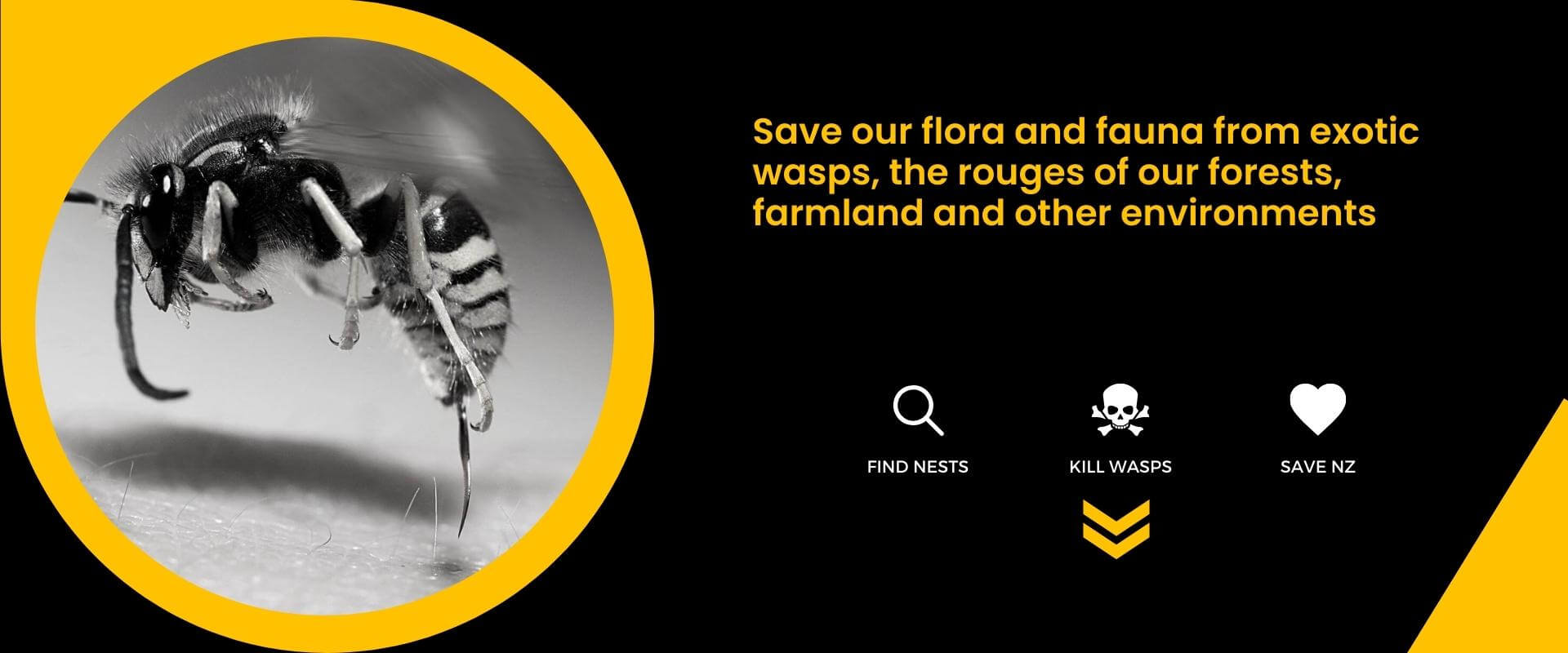
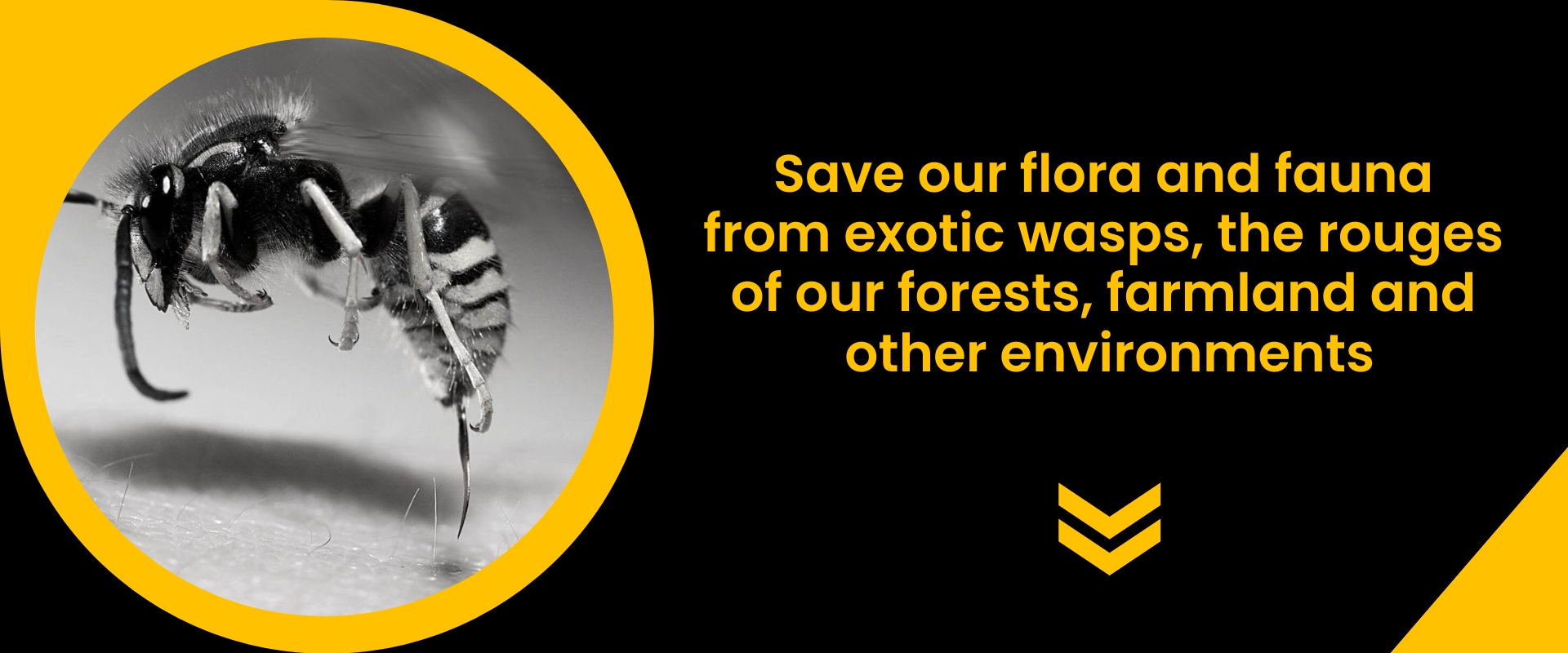
How to Waste Queen Wasps and Wasp nests

How to Spot Common and German Queen Wasps
Wasp nests do not usually survive the winter, with all worker wasps along with the old queen, dying in April or May. However, the newly hatched queen wasps stay alive by hibernating in wood piles or behind the bark on trees. A nest can produce between 1000 and 2000 queens per season, of which around 2% or on average 30 survive the winter. This may not seem good odds or high numbers, but you do the maths; 30 surviving queens each produce 30 surviving queens = 900 queens in 2 seasons multiplied by an average of 4500 wasps per nest or 4.05 million wasps – this is what our indigenous animals are up against.
In early spring, around September but earlier if in the far north, the Queen wasps begin to fly and look for places to build their nests. They start their own nest, building a honeycomb structure out of wood fibre, and lay the first eggs. The time between laying the eggs and the emergence of the first worker wasps is 28 and 48 days. So over 4 – 7 weeks before the worker wasps emerge, any flying wasp you see is most likely to be queen, also, she looks larger than a worker wasp measuring around 2-2.5cm in length, compared with workers of approximately 1.2-1.7cm in length.
If one queen wasp is killed, a potential of between 3000 and 6000 worker wasps are eliminated, and tens of thousands of insects and litres and litres of honeydew are saved for our indigenous fauna.
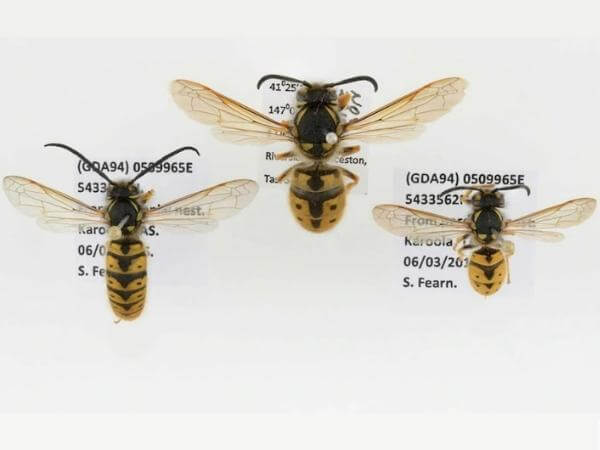
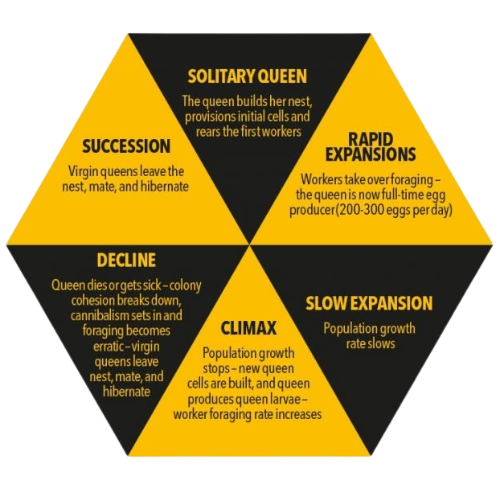
How to catch and waste a Common or German queen wasp
Apart from wasting a wasp with a rolled-up newspaper, queens can be caught in a simple home-made trap which should be put out from early spring to early summer during the time the queen wasps are flying so knowing about the queens lifecycle is handy.
Alternatively, you can use manufactured traps that can be attached to existing containers or use fully manufactured traps including containers which can be hung in bushes or trees. A manufactured or homemade lure which only attracts wasps, can be poured into the trap. The container must be emptied, and lure replaced once full of queen wasps.
There is little point in catching worker wasps because there are thousands of them so once you start catching them it is better to retire the traps until early spring and go after the nests themselves.
How to spot a Common or German Wasp Nest
- Identify the wasps – to see if they are either Common, German or paper wasps and ensure they are not beneficial honey bees, bumblebees or hoverflies.
- Watch the wasps – Wasps are not naturally aggressive so you can safely watch wasp activity from a few metres away. The wasps can be seen feeding at flowers, a spill of sugary drink and other food, or chewing on wooden fencing.
- Best time to spot wasps – just when the sun is coming up or going down, the flying wasps are lit up by the slanting light and if you watch them against a darker background, you can see where they are going or coming from. Wasps do not fly very far.
- Bait and watch – In late summer you can put out food/bait for the wasps such as cat food or tinned fish (not in brine or oil) and they will scoop up a lump and carry it back to their nest. You may be able to follow the wasps carrying their load of bait.
- The Wasp Flight Path – Once they have fed, they tend to fly in a straight line, a bit like a bullet, usually about 10 to 20 meters above the ground, back to their nest and within 5 meters of the nest curve down into the nest. Particularly on warm sunny days, a stream of wasps may be seen entering and leaving via the nest entrance.
- Follow – After 5-10 minutes watching the wasps, you will get an idea of the direction of the nest. Follow the wasps and look for somewhere the wasps are funneling into a hole. You may see wasps flying in the opposite direction out of the hole in search of food.
Only for wasp nest hunters 16 years and older and those who know what they are doing
How to Waste a German or common Wasp Nest
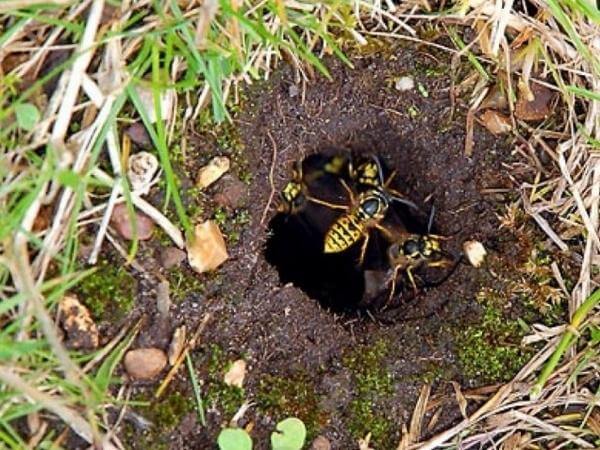
If you find a Common or German wasp nest during the day, stay several meters away from it or approach carefully and quietly. Though wasps are not particularly aggressive, they will attack if you step on or harm their nest. If you look carefully, you may spot wasps hovering around, not going anywhere. This means the wasps have been alerted to a potential threat, so keep still if you wish to keep on observing or slowly beat a retreat. If you want to kill a wasp nest any time before late summer or autumn your best option is to wait until first in the morning when they are cold and slow or late in the evening when all the wasps are drowsy and tucked into their nest. Then, with or without (depending on your level of confidence) a hollow plastic tube attached to the top of the bottle, pump several puffs of wasp powder straight down the hole at the entranceway. If you are using a torch to see your way, be careful not to shine it straight down the hole or the wasps will fly out to see what’s up. If you need help killing the wasp nest, contact the Wasps Wasters team or your local pest control person, and they’ll come running.
Nest activity and expansion starts to rachet up in December and by February/March the nest is particularly voracious. The incumbent queen starts to produce queens and drones over this time and 1000 to 2000 queens are produced, with mating occurring in March. To support the massive nest the worker wasps feed the wasp lavae extra protein – insects, spiders, baby birds, anything they can find. No insect is safe. During this time Vespex is also a good way to kill wasps but you need a special licence to use it. However, there are Community Vespex Licence holders who are trained in the use of Vespex and for a fee, will place it around your property so wasps can collect it, take it to their nests, feed their larvae with it, and consequently kill the nest.
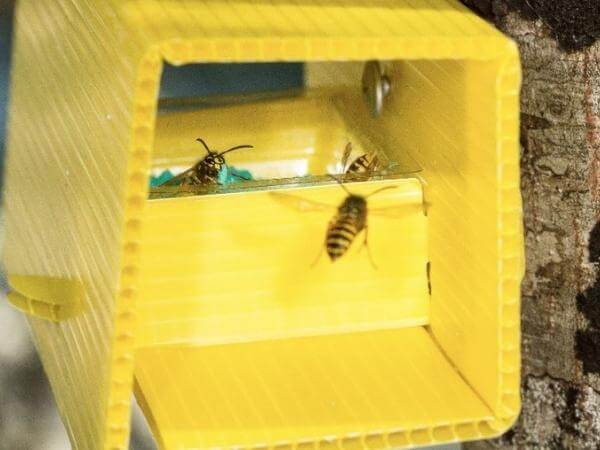
Tasmanian (Australian) or Asian Paper Wasps

How to spot and waste Tasmanian or Asian paper wasps and their wasp nests
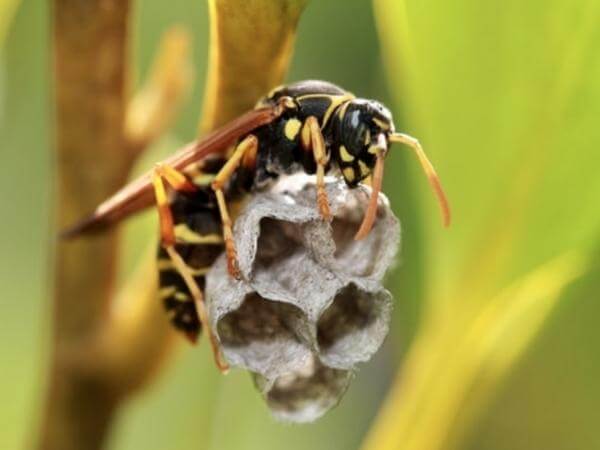
These guys are smaller and thinner looking than the German and common wasps, measuring from 13 to 25mm long. They are yellow and black (Asian) or brown and yellow (Australian) and have long legs which dangle beneath their bodies during flight. For most of the year only females are seen, but in the autumn males appear. These are smaller and don’t sting. Much of the swarming activity that occurs in Autumn is courtship behaviour and a very high proportion of the wasps appear to be males – so those swarms may not be as big a health hazard as they seem.
If you have a bunch of paper wasps at your place, have a closer look and see if you can tell how many females you’ve got, since they are really the only ones to worry about. They stand out among the males as being bigger and with Asian wasps, are blacker. They have faces which are striped yellow and black, while males’ faces are almost entirely yellow; males also have antennae that are curled at the end, and more extensive yellow colouring overall. If you’re struggling to see the differences, try spraying a few and checking them out more closely once they’re dead. But be careful because it’s possible to get a sting even from a dead female. •
After mating the males die, while the females retire to sheltered spots such as woodpiles to over-winter.
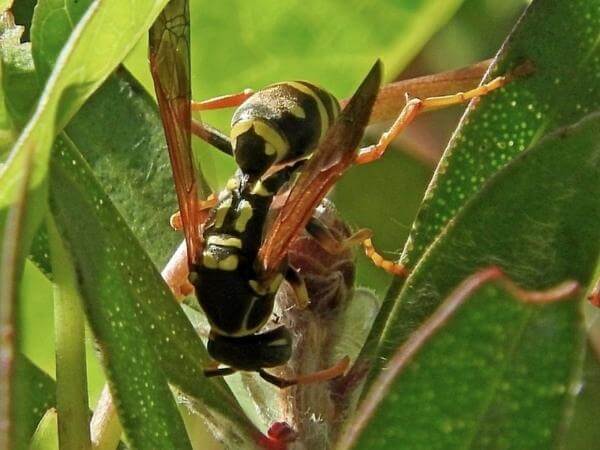
How to spot a paper wasp nest
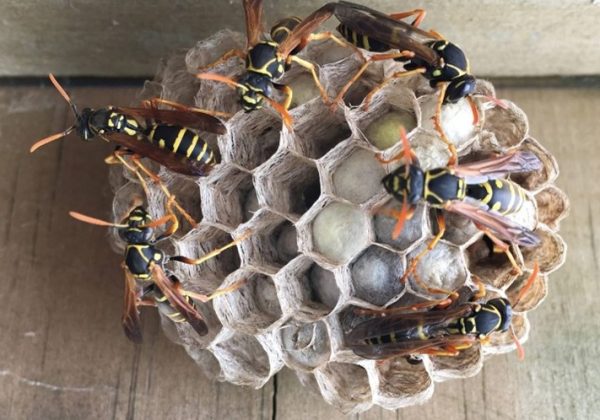
Since they target live prey, paper wasps are much harder to trap or entice with baits or poisons, though it has been suggested that tinned fish (in spring water) can be used as a lure. Paper wasps build much smaller nests than common or German wasps, and each must be handled individually. Paper wasps are slow- flying so they are easy to follow and by looking under large leaves, branches or eaves are relatively easy to find.
How to Waste the Paper Wasp nests
More care must be taken with paper wasp nest, because spraying the nest with liquid can make the wasps aggressive, and powder must be applied from very close range. It’s best to cover up as much as possible before tackling a paper wasp nest. Although it is tempting to have a crack at them when you discover the nest, wait until evening or first thing in the morning when the wasps are, literally, chilled. Note where the nest is and go back later with the fly-spray. Once the wasps are gone remove the nest and burn it, if possible, as other wasps will plunder it for material for their own building projects.

wasp nest wasting products
- Powder – This is puffed directly down the entrance hole of the nest.
- No Wasps Eliminator by Kiwicare
- Nest Removal – Rentokill offer Wasp nest removal services.
- Granulated protein Lure – Attracts worker wasps in late Summer and Autumn. The worker wasps take the Vespex to the nest and feed it to the queen and grubs. Only people with a Vespex license can use Vespex.
- Sprays – Any type of fly spray can be used against hanging paper wasp nests and all flying wasps. It is relatively ineffective against Common or German in-ground wasp nests. No Wasps Total Protection Spray is used to deter flying wasps from hovering around windowsills and the like but does not kill them. Maybe effective on wood piles that are protected from the rain to prevent queen wasps from hibernating there in the Autumn.
- No Wasps Total Protection Spray by Kiwicare
Health & Safety around wasps and wasp nests
Be prepared for a potential sting and take all precautions against upsetting the wasps in a nest.
It is important that you understand that wasps can sting and unlike bees, which can only sting once,
are able to sting several times and through clothing as well!
Children – never try to waste a wasp nest without an adult present
